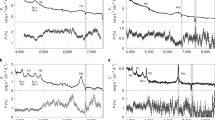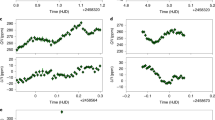Abstract
Polarization in stars was first predicted by Chandrasekhar1, who calculated a substantial linear polarization at the stellar limb for a pure electron-scattering atmosphere. This polarization will average to zero when integrated over a spherical star but could be detected if the symmetry was broken, for example, by the eclipse of a binary companion. Nearly 50 years ago, Harrington and Collins2 modelled another way of breaking the symmetry and producing net polarization—the distortion of a rapidly rotating hot star. Here we report the first detection of this effect. Observations of the linear polarization of Regulus, with two different high-precision polarimeters, range from +42 ppm at a wavelength of 741 nm to –22 ppm at 395 nm. The reversal from red to blue is a distinctive feature of rotation-induced polarization. Using a new set of models for the polarization of rapidly rotating stars, we find that Regulus is rotating at \(96.{5}_{-0.8}^{+0.6} \% \) of its critical angular velocity for break-up, and has an inclination greater than 76.5°. The rotation axis of the star is at a position angle of 79.5 ± 0.7°. The conclusions are independent of, but in good agreement with, the results of previously published interferometric observations of Regulus3. The accurate measurement of rotation in early-type stars is important for understanding their stellar environments4 and the course of their evolution5.
This is a preview of subscription content, access via your institution
Access options
Access Nature and 54 other Nature Portfolio journals
Get Nature+, our best-value online-access subscription
$29.99 / 30 days
cancel any time
Subscribe to this journal
Receive 12 digital issues and online access to articles
$119.00 per year
only $9.92 per issue
Buy this article
- Purchase on Springer Link
- Instant access to full article PDF
Prices may be subject to local taxes which are calculated during checkout




Similar content being viewed by others
References
Chandrasekhar, S. On the radiative equilibrium of a stellar atmosphere. X. Astrophys. J. 103, 351–370 (1946).
Harrington, J. P. & Collins, G. W. Intrinsic polarization of rapidly rotating early-type stars. Astrophys. J. 151, 1051–1056 (1968).
Che, X. et al. Colder and hotter: interferometric imaging of β Cassiopeiae and α Leonis. Astrophys. J. 732, 68 (2011).
Cranmer, S. R. & Owocki, S. P. The effect of oblateness and gravity darkening on the radiation driving winds from rapidly rotating B stars. Astrophys. J. 440, 308–321 (1995).
McAlister, H. A. et al. First results from the CHARA array. I. An interferometric and spectroscopic study of the fast rotator α Leonis (Regulus). Astrophys. J. 628, 439–452 (2005).
Hiltner, W. A. Polarization of radiation from distant stars by the interstellar medium. Nature 163, 283 (1949).
Hall, J. S. Observations of the polarized light from stars. Science 109, 166–167 (1949).
Kemp, J. C., Henson, G. D., Barbour, M. S., Kraus, D. J. & Collins, G. W. Discovery of eclipse polarization in Algol. Astrophys. J. Lett. 273, L85–L88 (1983).
Collins, G. W. II Intrinsic polarization in nongray atmospheres. Astrophys. J. 159, 583–591 (1970).
Sonneborn, G. in Be Stars (eds Jaschek M. & Groth H.-G.) 493–496 (Reidel, Dordrecht, 1982).
Coyne, G. V. & Kruszewski, A. Wavelength dependence of polarization. XVII. Be-type stars. Astron. J. 74, 528–532 (1969).
Clarke, D. Stellar Polarimetry (Wiley-VCH, Weinheim, 2010).
Porter, J. M. & Rivinius, T. Classical Be stars. Publ. Astron. Soc. Pacific 115, 1153–1170 (2003).
Bailey, J. et al. A high-sensitivity polarimeter using a ferro-electric liquid crystal modulator. Mon. Not. R. Astron. Soc. 449, 3064–3073 (2015).
Hough, J. H. et al. PlanetPol: a very high sensitivity polarimeter. Publ. Astron. Soc. Pacific 118, 1302–1318 (2006).
Wiktorowicz, S. J. & Matthews, K. A high-precision optical polarimeter to measure inclinations of high-mass X-ray binaries. Publ. Astron. Soc. Pacific 120, 1282–1297 (2008).
Bailey, J., Lucas, P. W. & Hough, J. H. The linear polarization of nearby bright stars measured at the parts per million level. Mon. Not. R. Astron. Soc. 405, 2570–2578 (2010).
Harrington, J. P. in Polarimetry: From the Sun to Stars and Stellar Environments. Proc. IAU 10, 395–400 (2015).
Espinosa Lara, F. & Rieutord, M. Gravity darkening in rotating stars. Astron. Astrophys. 533, A43 (2011).
von Zeipel, H. The radiative equilibrium of a rotating system of gaseous masses. Mon. Not. R. Astron. Soc 84, 665–683 (1924).
Kurucz, R. ATLAS9 Stellar Atmosphere Programs and 2 km/s grid. Kurucz CD-ROM No. 13 (1993).
Hubney, I., Stefl, S. & Harmanec, P. How strong is the evidence of superionization and large mass outflows in B/Be stars? Bull. Astron. Inst. Czech. 36, 214–230 (1985).
Spurr, R. J. D. VLIDORT: a linearized pseudo-spherical vector discrete ordinate radiative transfer code for forward model and retrieval studies in multilayer scattering media. J. Quant. Spectrosc. Radiat. Transf. 102, 316–342 (2006).
Howarth, I. D. & Smith, K. C. Rotational mixing in early-type main-sequence stars. Mon. Not. R. Astron. Soc. 327, 353–368 (2001).
Öhman, Y. On the possibility of tracing polarization effects in the rotational profiles of early-type stars. Astrophys. J. 104, 460–462 (1946).
Cotton, D. V. et al. The linear polarization of Southern bright stars measured at the parts-per-million level. Mon. Not. R. Astron. Soc. 455, 1607–1628 (2016).
Marshall, J. P. et al. Polarization measurements of hot dust stars and the local interstellar medium. Astrophys. J. 825, 124 (2016).
Cotton, D. V. et al. The intrinsic and interstellar broad-band linear polarization of nearby FGK dwarfs. Mon. Not. R. Astron. Soc. 467, 873–897 (2017).
Thureau, N. D. et al. An unbiased study of debris discs around A-type stars with Herschel. Mon. Not. R. Astron. Soc. 445, 2558–2573 (2014).
Frisch, P. C. et al. Following the interstellar magnetic field from the heliosphere into space with polarized starlight. J. Phys. Conf. Ser. 767, 012010 (2016).
van Leeuwen, F. Validation of the new Hipparcos reduction. Astron. Astrophys. 474, 653–664 (2007).
Serkowski, K., Mathewson, D. S. & Ford, V. L. Wavelength dependence of interstellar polarization and ratio of total to selective extinction. Astrophys. J. 196, 261–290 (1975).
Wilking, B. A., Lebofsky, M. J. & Rieke, G. H. The wavelength dependence of interstellar linear polarization: stars with extreme values of λ max. Astron. J. 87, 695–697 (1982).
Hiltner, W. A. Interstellar polarization. Vistas Astron 2, 1080–1091 (1956).
Slettebak, A., Collins, G. W. II, Parkinson, T. D., Boyce, P. B. & White, N. M. A system of standard stars for rotational velocity determinations. Astrophys. J. Supp. Ser. 29, 137–159 (1975).
Zorec, J. & Royer, F. Rotational velocities of A-type stars. IV. Evolution of rotational velocities. Astron. Astrophys. 537, A120 (2012).
Dekker, H., D’Odorico, S., Kaufer, A., Delabre, B. & Kotzlowski, H. Design, construction, and performance of UVES, the echelle spectrograph for the UT2 Kueyen Telescope at the ESO Paranal Observatory. Proc. SPIE 4008, 534–545 (2000).
Pepe, F. et al. HARPS: a new high-resolution spectrograph for the search of extrasolar planets. Proc. SPIE 4008, 582–592 (2000).
Kaufer, A. & Pasquini, L. FEROS: the new fiber-linked echelle spectrograph for the ESO 1.52-m telescope. Proc. SPIE 3355, 844–854 (1998).
Baranne, A. et al. ELODIE: a spectrograph for accurate radial velocity measurements. Astron. Astrophys. Supp. Ser 119, 373–390 (1996).
Gavrilović, N. & Jankov, S. in Active OB-Stars: Laboratories for Stellar and Circumstellar Physics. ASP Conf. Ser. 425–427 (Astronomical Society of the Pacific, 2007).
Townsend, R. H. D., Owocki, S. P. & Howarth, I. D. Be-star rotation: how close to critical? Mon. Not. R. Astron. Soc 350, 189–195 (2004).
Gray, D. F. The Observation and Analysis of Stellar Photospheres 3rd edn (Cambridge Univ. Press, Cambridge, 2005).
Howarth, I. D. & Morello, G. Rapid rotators revisited: absolute dimensions of KOI-13. Mon. Not. R. Astron. Soc 470, 932–939 (2017).
Howarth, I. D. New limb-darkening coefficients and synthetic photometry for model-atmosphere grids at Galactic, LMC, and SMC abundances. Mon. Not. R. Astron. Soc. 413, 1515–1523 (2011).
Castelli, F. & Kurucz, R. New grids of ATLAS9 model atmospheres. Preprint at http://arXiv.org/abs/astroph/0405087 (2004).
Grevesse, N. & Sauval, A. J. Standard solar composition. Space Sci. Rev 85, 161–174 (1998).
Hubeny, I. & Lanz, T. Non-LTE line-blanketed model atmospheres of hot stars. 1: Hybrid complete linearization/accelerated lambda iteration method. Astrophys. J. 439, 875–904 (1995).
Acknowledgements
The work was supported by the Australian Research Council through Discovery Project grants DP140100121 and DP160103231. We thank D. Opitz, J. Sturges and the staff at the AAT for their assistance in making the HIPPI observations. We thank R. Spurr of RT Solutions for providing the VLIDORT software.
Author information
Authors and Affiliations
Contributions
J.B., D.V.C., L.K.-C., K.B., P.W.L. and J.H.H. drafted the initial proposals to observe Regulus with HIPPI, following an extended discussion of the PlanetPol results dating back to 2010 that included I.D.H., J.H.H., J.B. and P.W.L. All authors contributed to the discussion and drafting of the final manuscript. The HIPPI observations were carried out and directed by J.B., D.V.C., L.K.-C. and K.B. In addition, the following authors made specific contributions to the work: D.V.C. contributed the initial data analysis, telescope polarization subtraction, stellar atmosphere modelling, interstellar subtraction, model comparison to data, and other calculations including the position angle calculation and the calculations related to Regulus’ companions. J.B. contributed the polarized radiative transfer modelling and verification, gravity-darkening calculations and PlanetPol bandpass model calculations and code. I.D.H. contributed rotational velocity calculations, the knowledge and calculations needed to constrain parameter space, and other miscellaneous calculations. K.B. contributed HIPPI bandpass model calculations and code, and research on Regulus’ companions. P.W.L. contributed details of the PlanetPol observations not otherwise available.
Corresponding author
Ethics declarations
Competing interests
The authors declare no competing financial interests.
Additional information
Publisher’s note: Springer Nature remains neutral with regard to jurisdictional claims in published maps and institutional affiliations.
Electronic supplementary material
Supplementary Information
Supplementary Text, Supplementary References, Supplementary Figures 1–6 and Supplementary Tables 1–8
Rights and permissions
About this article
Cite this article
Cotton, D.V., Bailey, J., Howarth, I.D. et al. Polarization due to rotational distortion in the bright star Regulus. Nat Astron 1, 690–696 (2017). https://doi.org/10.1038/s41550-017-0238-6
Received:
Accepted:
Published:
Issue Date:
DOI: https://doi.org/10.1038/s41550-017-0238-6



